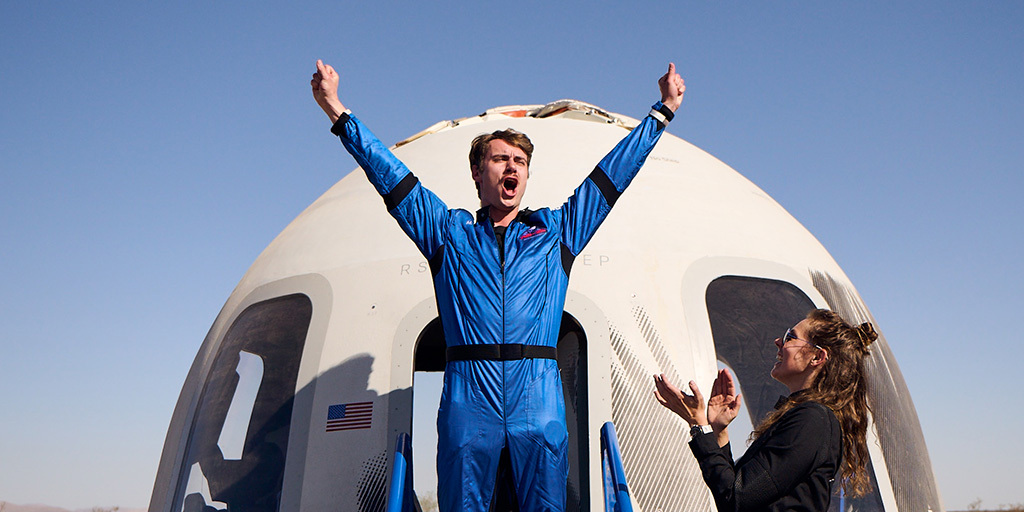Welcome to our first episode of Space Lobster News Brief! In today’s episode, we’ll be diving into the latest and most significant developments in the world of space exploration that you might have missed. From crewed flights to rocket milestones, here are the top five stories you need to know about. Listen to the podcast below.
Blue Origin’s New Shepard Crewed Flight
On May 19, 2024, Blue Origin marked a significant milestone with the launch of NS-25, the seventh human flight of their New Shepard vehicle. This mission is notable for several reasons. The New Shepard capsule, designed to accommodate six people, boasts large windows and a 15 cubic meter volume, providing passengers with an unparalleled view of space. The capsule is equipped with an abort motor to ensure the crew’s safety.
The rocket itself is powered by a single BE-3 engine, generating 490 kN of thrust, and features a reusable booster. This flight marks Blue Origin’s return to crewed missions since August 2022. The hiatus was due to an anomaly on the NS-23 mission in September 2022, where a thermo-structural failure of the engine nozzle caused a misalignment of thrust. This incident triggered the escape system, destroying the NS3 booster, although the capsule, RSS H.G. Wells, performed a successful in-flight escape.
Today’s launch occurred at 9:36 AM CDT, featuring a diverse crew: Mason Angel, Sylvain Chiron, Kenneth L. Hess, Carol Schaller, Gopi Thotakura, and Ed Dwight. Dwight, a former Air Force Captain, was trained as an astronaut candidate in the 1960s and was chosen by President John F. Kennedy for NASA Astronaut Corps training. Despite not being selected as an astronaut due to racial politics, Dwight pursued a successful career in engineering, restaurant ownership, and art as a sculptor.
During today’s mission, a parachute anomaly occurred when one of the three parachutes failed to disreef, a process designed to prevent an extreme jerk at deployment. Fortunately, the capsule is built to land safely even under two parachutes, ensuring the crew’s safety.
Boeing’s Starliner Crew Flight Test Delay
Boeing has announced a delay in the launch of their Starliner Crew Flight Test due to the need for further analysis and testing of a helium leak. Originally scheduled for earlier, the new target launch date is now set for May 25, at 3:09 p.m. EDT. This mission will see NASA astronauts Butch Wilmore and Suni Williams spend eight days aboard the International Space Station (ISS).
The delay was prompted by a helium leak detected on May 6, which was traced to a single Reaction Control System (RCS) thruster. Additionally, a pressure relief valve issue on the Atlas 5 rocket’s Centaur upper stage led to a mission scrub. Boeing has since replaced the faulty valve and conducted further testing. As of May 15, the helium leak appears stable, and the thruster system has been effectively sealed.
Wilmore and Williams have returned to Houston for additional training while Boeing continues to refine operational procedures to ensure system reliability. The Starliner is designed to work alongside SpaceX’s Crew Dragon, despite facing numerous challenges and developmental hurdles in its journey to operational status.
SpaceX Reusability Milestone
On May 17, 2024, SpaceX achieved a remarkable milestone with the Falcon 9 rocket’s first-stage booster, B1062, completing its 21st launch. This mission, designated Starlink 6-59, successfully added 23 new satellites to the ever-growing Starlink constellation.
The booster B1062 has a storied history, having previously launched GPS satellites, the Inspiration-4 mission, Axiom-1, and multiple Starlink flights. The recent mission culminated in a successful landing on the droneship ‘A Shortfall of Gravitas,’ marking the 70th landing on this particular droneship and the 309th overall for SpaceX.
As of May 17, there are 6,017 total Starlink satellites in orbit, with 5,941 operational, according to astronomer Jonathan McDowell. This achievement underscores SpaceX’s ongoing commitment to expanding global internet coverage through their Starlink constellation.
SpaceX Surpasses Shuttle Missions
In a significant milestone, SpaceX’s Falcon family has surpassed the number of Space Shuttle launches from Launch Complex 39A at Kennedy Space Center. The Starlink 6-56 mission, launched on a Falcon 9 rocket on May 8, 2024, at 2:42 p.m. EDT, marked the 83rd orbital launch from SpaceX’s KSC pad. This exceeds the 82 shuttle launches conducted over the 30-year history of the Space Shuttle program.
The booster for this mission, B1083, launched for the third time and landed successfully on ‘A Shortfall of Gravitas.’ There is speculation that B1083 might be used for the upcoming Polaris Dawn mission, hinted at by Jared Isaacman.
Starship Flight Four Development
SpaceX is making strides in preparing for the fourth integrated flight test of their Starship vehicle. On May 15, the rocket was stacked at Starbase, followed by a partial wet dress rehearsal on May 16. The launch is pending the issuance of a license from the FAA.
Elon Musk has estimated a launch timeframe of “three to five weeks” as of May 11, with Kathy Leuders suggesting the end of May or early June as potential dates. The FAA has indicated that if no public safety issues are identified in the ongoing mishap investigation, SpaceX may return to flight while the investigation remains open, provided all other license requirements are met.
Conclusion
These recent developments highlight the dynamic and rapidly evolving landscape of space exploration. From Blue Origin’s return to crewed flights to SpaceX’s ongoing achievements, the future of space travel continues to look promising. Stay tuned for more updates and in-depth coverage on these and other exciting space stories. Don’t forget to subscribe to Space Lobster News Brief for your regular dose of space news!
Feel free to leave any feedback or questions in the comments below. Until next time, keep looking up!


Leave A Comment